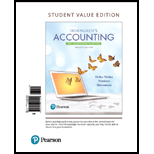
Which principle or concept states that business should use the same accounting methods and procedures from period to period?
Learning Objective 1
a. Disclosure
b. Conservatism
c. Consistency
d. Materiality
Accounting principles:The accounting principles are rules of action or conduct which are adopted by the accountants universally while recording accounting transactions. These guidelines are commonly associated with the theory and procedures of accounting of the companies that follow certain structure for reporting financial statements.
To identify:
The principles that states business shall use same accounting procedures from period to period
Answer to Problem 1QC
Solution:
c. The Consistency principle states that business shall have same accounting procedures from period to period.
Explanation of Solution
a) Disclosure −As per the disclosure principle, the firm shall disclose all the relevant information that users of financial statements have a right to know. This information should cover the relevant, reliable and comparable information of the company so that users can use this information to make wise decisions.
b) Conservatism - The goal is to conserve the realistic figures. Its nature is to caution the reporting items in financial statements. Example- “Anticipate no gains, but provide for all losses”
c) Consistency - This principle means once it’s being adopted, it must be applied consistently in future. It helps investors and users of financial statements to easily and correctly compare financial statements of a company from one period to the next.
d) Materiality - The materiality concept applies when it would cause someone to change a decision regarding the information of material used. It is only significant for some items. It doesn’t include all the company. For example − The materials used in the company Apple is not that significant when compared to smaller firms.
The consistency principle states that business has same accounting procedures from period to period. All other principles like disclosure, conservatism and materiality concepts ignore the accounting procedures which carry from period to period.
Want to see more full solutions like this?
Chapter 6 Solutions
Horngren's Accounting: The Managerial Chapters, Student Value Edition (12th Edition)
Additional Business Textbook Solutions
Horngren's Financial & Managerial Accounting, The Financial Chapters (Book & Access Card)
Business Essentials (12th Edition) (What's New in Intro to Business)
FUNDAMENTALS OF CORPORATE FINANCE
Essentials of Corporate Finance (Mcgraw-hill/Irwin Series in Finance, Insurance, and Real Estate)
Corporate Finance (4th Edition) (Pearson Series in Finance) - Standalone book
Fundamentals of Management (10th Edition)
- Please provide the solution to this financial accounting question using proper accounting principles.arrow_forwardI need help solving this general accounting question with the proper methodology.arrow_forwardCan you explain this general accounting question using accurate calculation methods?arrow_forward
- Can you help me solve this general accounting problem using the correct accounting process?arrow_forwardI need help finding the accurate solution to this financial accounting problem with valid methods.arrow_forwardPlease provide the correct answer to this general accounting problem using valid calculations.arrow_forward
 Intermediate Accounting: Reporting And AnalysisAccountingISBN:9781337788281Author:James M. Wahlen, Jefferson P. Jones, Donald PagachPublisher:Cengage LearningPrinciples of Accounting Volume 1AccountingISBN:9781947172685Author:OpenStaxPublisher:OpenStax CollegePrinciples of Accounting Volume 2AccountingISBN:9781947172609Author:OpenStaxPublisher:OpenStax College
Intermediate Accounting: Reporting And AnalysisAccountingISBN:9781337788281Author:James M. Wahlen, Jefferson P. Jones, Donald PagachPublisher:Cengage LearningPrinciples of Accounting Volume 1AccountingISBN:9781947172685Author:OpenStaxPublisher:OpenStax CollegePrinciples of Accounting Volume 2AccountingISBN:9781947172609Author:OpenStaxPublisher:OpenStax College Cornerstones of Cost Management (Cornerstones Ser...AccountingISBN:9781305970663Author:Don R. Hansen, Maryanne M. MowenPublisher:Cengage Learning
Cornerstones of Cost Management (Cornerstones Ser...AccountingISBN:9781305970663Author:Don R. Hansen, Maryanne M. MowenPublisher:Cengage Learning Auditing: A Risk Based-Approach (MindTap Course L...AccountingISBN:9781337619455Author:Karla M Johnstone, Audrey A. Gramling, Larry E. RittenbergPublisher:Cengage Learning
Auditing: A Risk Based-Approach (MindTap Course L...AccountingISBN:9781337619455Author:Karla M Johnstone, Audrey A. Gramling, Larry E. RittenbergPublisher:Cengage Learning College Accounting, Chapters 1-27AccountingISBN:9781337794756Author:HEINTZ, James A.Publisher:Cengage Learning,
College Accounting, Chapters 1-27AccountingISBN:9781337794756Author:HEINTZ, James A.Publisher:Cengage Learning,





